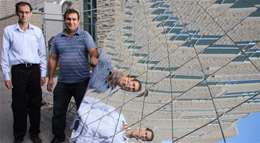Solar dish research focused on future

Do you remember as a kid using a magnifying glass to generate intense heat to burn a leaf? Technology has come a long way since then, and the work of Western Engineering professor Kamran Siddiqui in the area of solar energy research is taking the use of this free energy resource to new levels.
“You don’t need to be a scientist to know that solar panel heats up, but how to use this heat efficiently is where the technical knowledge is needed and the science comes in,” Siddiqui says.
With a background in heat transfer fluid mechanics, Siddiqui is working on a number of solar-based projects, such as solar water heaters and a solar wall, each with a wide variety of natural and engineering applications. The latest project looks at different kind of solar system - a parabolic solar dish. Looking much like a large satellite dish, the solar energy in this case is captured into a small enclosure, which produces a huge amount of heat energy - in the neighbourhood of 50-1000 degrees Celsius.
In concentrated solar energy systems, the incident solar radiation is focused into an enclosure through optical devices where the now-concentrated radiation is converted into heat.
“Once you concentrate that heat energy is when you can reach very high temperatures,” says Siddiqui, adding some studies have suggested that solar radiation on Earth is about 15,000 times what we need globally. “And there are a variety of different applications once you have this heat. Solar energy has a very strong potential in terms of meeting energy demands.”
The idea is to use the generated heat to create steam to drive a generator and subsequently produce electricity for heating and even cooling purposes.
“There are several fundamental aspects that still need to be explored, especially with the receiver,” says Siddiqui. “We effectively have to design this component so that the steam can be produced inside the receiver. “
This research and commercialization project is a collaboration with Canada-based Admira Distributed Hybrid Energy Systems Inc., headed up by environmental and renewable energy engineer Sujit Sengupta.
With a planned focus on Indian and North American markets, Sengupta touched based last year with a number of Ontario universities regarding a research and development partnership to face the challenges of an ecologically friendly and greener future.
“Western is doing very good research in terms of bio-hydrogen and solar technologies, so I found that good and said, ‘Let’s do it,’” says Sengupta, who spent four weeks at Western this past summer to help build the dish, with the help of the University Machine Shop. “In interacting with the professors and researchers, I want to have a strong relationship with Western in terms of research and commercialization.”
Sengupta adds the project is evolving and he will commercialize and prototype six solar thermal units at Western, using the experience at the university to develop different applications of power, pyrolysis, heating, cooling, cleaning water and hydro-cracking, along with building a further 100 dishes using this technology and research for his projects in the next three years.
With a second dish being constructed and Sengupta and Siddiqui are awaiting to hear about possible Natural Sciences and Engineering Research Council of Canada funding to further their research collaboration.
Provided by University of Western Ontario

















